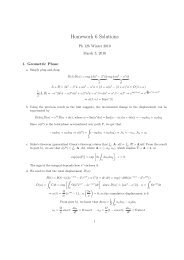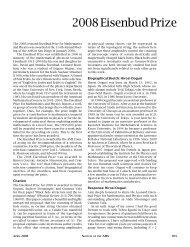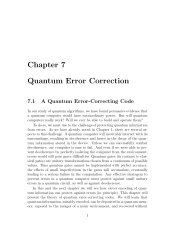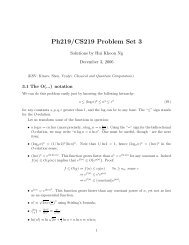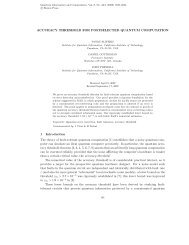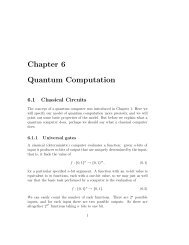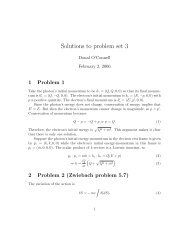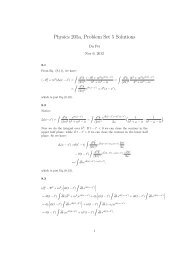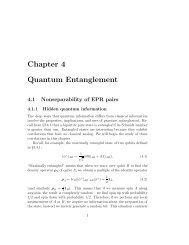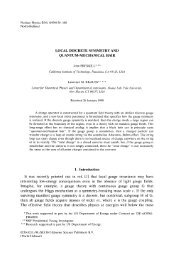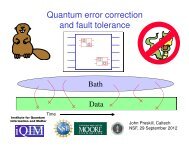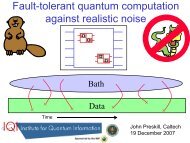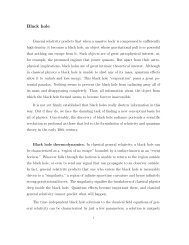Cosmic Strings and Other Topological Defects by A. Vilenkin and ...
Cosmic Strings and Other Topological Defects by A. Vilenkin and ...
Cosmic Strings and Other Topological Defects by A. Vilenkin and ...
You also want an ePaper? Increase the reach of your titles
YUMPU automatically turns print PDFs into web optimized ePapers that Google loves.
<strong>Cosmic</strong> <strong>Strings</strong> <strong>and</strong> <strong>Other</strong> <strong>Topological</strong> <strong>Defects</strong><br />
<strong>by</strong> A. <strong>Vilenkin</strong> <strong>and</strong> E. P. S. Shellard<br />
Reviewed <strong>by</strong> John Preskill<br />
28 March 1996<br />
One of the most ironic twists of twentieth century science, <strong>and</strong> one of the most exciting<br />
<strong>and</strong> productive, has been the merging of the study of the very large <strong>and</strong> the very small—<br />
the unification of particle physics <strong>and</strong> cosmology. Particle physics traditionally addresses<br />
the structure of matter at the shortest accessible distances (or, equivalently, at the highest<br />
possible energies). Cosmology concerns the structure <strong>and</strong> the evolution of the whole universe.<br />
Particle physics has had great success over the past 30 years. A “st<strong>and</strong>ard model”<br />
is now firmly in place that can account for all of the available experimental evidence. But<br />
the st<strong>and</strong>ard model is not a final theory; it leaves unanswered too many fundamental questions.<br />
Only <strong>by</strong> pressing on to study physics at still shorter distances <strong>and</strong> higher energies<br />
(physics beyond the st<strong>and</strong>ard model) can these final mysteries be resolved. Cosmology has<br />
also had great success over the past 30 years. A “st<strong>and</strong>ard model” is in place that gives<br />
a reasonable (though perhaps not fully satisfactory) account of the available observations.<br />
But the st<strong>and</strong>ard model is not a final theory; it leaves unanswered too many questions,<br />
especially questions about the “initial” conditions that applied in the very early universe.<br />
Only <strong>by</strong> pressing on to study the history of the universe at still earlier times can these<br />
final mysteries be resolved. But at earlier times the universe was hotter, <strong>and</strong> we can extend<br />
the study of the universe to the very earliest times only <strong>by</strong> considering the behavior<br />
of matter at the very highest energies. Thus, with the deepest questions about particle<br />
1
physics pointing us to ever smaller distances, <strong>and</strong> the deepest questions about cosmology<br />
pointing us to ever earlier times, the study of the elementary particle meets the study of<br />
the universe—cosmology <strong>and</strong> particle physics are one.<br />
The essential thrust of this unification is twofold. In particle physics, the most energetic<br />
current accelerator experiments can resolve the structure of matter at a distance<br />
scale of order 10 −16 cm. But particle theorists boldly speculate about the properties of the<br />
fundamental interactions down to distance scales of order 10 −33 cm. We crave experimental<br />
evidence to constrain these speculations, but no accelerator in the foreseeable future<br />
will be sufficiently energetic to probe this very-short-distance physics directly. Instead,<br />
particle physicists look to the early universe to serve as their accelerator. The universe<br />
was once so hot as to probe the behavior of matter at exceedingly short distances, <strong>and</strong> we<br />
can hope to detect surviving relics of that fiery past in today’s universe.<br />
The other side of the coin is that ideas from particle physics can illuminate the central<br />
questions of cosmology. Among these questions: Where did the matter of the universe<br />
come from? Why is the universe so large, so nearly isotropic, <strong>and</strong> so nearly homogeneous.<br />
What explains the origin of galaxies, of clusters of galaxies, of superclusters? What is the<br />
nature of the “dark matter” that dominates the halos of spiral galaxies? Since the late<br />
70’s, particle physics has offered a wealth of appealing answers to these questions. The<br />
only trouble is that there are too many mutually contradictory answers; they cannot all<br />
be right.<br />
A central theme of modern cosmology is the study of “large scale structure”—the way<br />
that the galaxies are distributed in the universe. The very early universe was much more<br />
2
homogeneous than the present universe. But small inhomogeneities were present even<br />
then, <strong>and</strong> due to their gravitational attraction, these fluctuations in the matter density<br />
grew, eventually condensing into the galaxies <strong>and</strong> other structures that we see today. The<br />
most fundamental question about the formation of galaxies is: what was the origin of<br />
the initial perturbations that eventually grew? Recent measurements of the microwave<br />
radiation left over from the big bang allow us to estimate the size of the fluctuations—the<br />
typical variation of the density about its mean value was only about one part in 10 5 —<strong>and</strong><br />
it is the task of fundamental theory to explain why this variation was so small.<br />
Two major competing models for the origin of the density perturbations have been<br />
proposed. In the “inflationary” model, the perturbations arose from quantum fluctuations,<br />
<strong>and</strong> can be understood as a consequence of the Heisenberg uncertainty principle. Indeed,<br />
these quantum fluctuations are almost certainly present at some level, but so far theorists<br />
have not offered any unambiguous prediction as to their magnitude. (The “natural”<br />
assumption seems to be that the fluctuations would be of order one, <strong>and</strong> we don’t underst<strong>and</strong><br />
why they should be so small as 10 −5 . The second model of the origin of large<br />
scale structure is the “cosmic string” model, <strong>and</strong> it provides the motivation <strong>and</strong> central<br />
focus for <strong>Cosmic</strong> <strong>Strings</strong> <strong>and</strong> <strong>Other</strong> <strong>Topological</strong> <strong>Defects</strong> <strong>by</strong> Alex<strong>and</strong>er <strong>Vilenkin</strong> <strong>and</strong> Paul<br />
Shellard. In this picture, the perturbations arose from a network of linear defects that<br />
were created during a phase transition that took place during the first 10 −37 seconds after<br />
the big bang. <strong>Vilenkin</strong> is one of the originators of this cosmic string scenario, <strong>and</strong> Shellard<br />
has been a leading contributor to its development. Their book is a remarkably complete<br />
<strong>and</strong> authoritative review of the broad range of physics issues underlying the scenario.<br />
3
<strong>Cosmic</strong> strings are closely analogous to the vortex lines that are seen in laboratory<br />
experiments with type-II superconductors, but with two important differences: the cosmic<br />
strings are defects in the vacuum rather than in a bulk state of matter, <strong>and</strong> the strings<br />
have an incredibly small thickness of order 10 −30 cm. Correspondingly, the strings are<br />
enormously heavy—with a mass per unit length of order 10 22 g/cm, or in units better suited<br />
to astrophysical applications, about 10 10 solar masses per kiloparsec. These numbers are<br />
obtained under the assumption that cosmic strings are indeed responsible for the primordial<br />
density perturbations, <strong>by</strong> fitting to the cosmic microwave observations.<br />
The chain of ideas connecting cosmic strings with the large scale structure of the<br />
universe is exceedingly intricate, <strong>and</strong> so <strong>Vilenkin</strong> <strong>and</strong> Shellard are compelled to cover a<br />
lot of terrain in this treatise. They discuss, for example, the classification of topological<br />
defects, the theory of phase transitions <strong>and</strong> of defect formation in a quench, the dynamics<br />
of strings <strong>and</strong> the interactions that occur when strings intersect, the gravitational effects<br />
of strings <strong>and</strong> how gravitational radiation modifies the evolution of the string network,<br />
<strong>and</strong> of course, the effect of strings on the microwave background <strong>and</strong> on the formation of<br />
structure.<br />
Indeed, the physics of the cosmic string scenario for structure formation is so complicated<br />
that even after fifteen years of intensive study, it is difficult to extract precise<br />
predictions that can be compared with the observations of the astronomers. Even the qualitative<br />
picture of how the scenario works has evolved substantially, especially as a result of<br />
improved numerical simulations of the evolution of the string network. <strong>Vilenkin</strong>’s original<br />
idea was that each galaxy was seeded <strong>by</strong> a closed loop of string, but the simulations showed<br />
4
that the loops that branch off of the string network are smaller than originally assumed, so<br />
that this proposal became untenable. Another idea was that gravitational focusing behind<br />
a moving open string would cause matter to accrete onto a sheet in the string’s wakes,<br />
enhancing the abundance of galaxies on the sheet. But the simulations showed that the<br />
open strings actually wiggle much more than originally expected, so that the wake picture<br />
also had to be modified. Current comparisons of the scenario with observation are still<br />
inconclusive, but the situation is bound to be clarified as both the simulations <strong>and</strong> the<br />
observations improve. Actually, the thing that surprised me most about this book is that<br />
so little is said about the confrontation of the scenario with the data. I suppose that the<br />
authors were worried that any detailed discussion would rapidly become obsolete.<br />
The proposal that cosmic strings guided the formation of the large scale structure<br />
of the universe is boldly speculative, <strong>and</strong> like most speculative ideas, it is likely to be<br />
wrong. But there are several potential observational smoking guns that could provide<br />
persuasive evidence in support of the scenario within the next decade—strings could be<br />
detected either through their influence on the microwave background anisotropy or due to<br />
their gravitational lensing properties. Such a discovery would be extraordinarily exciting<br />
for both particle physicists <strong>and</strong> cosmologists: for the particle physicist, the universe would<br />
provide us with a glimpse of short-distance physics well beyond the st<strong>and</strong>ard model; for the<br />
cosmologist, the structure of matter at 10 −30 cm would explain the shape of the cosmos.<br />
John Preskill is Professor of Theoretical Physics at the California Institute of Technology.<br />
He has contributed to the theory of topological defects <strong>and</strong> the theory of the early<br />
universe, among other issues in fundamental physics.<br />
5



